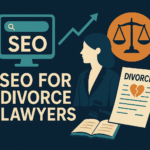When you search for law firm website design, you’re really looking for clarity, trust, and confident navigation, all delivered through design backed by powerful words. What too many firms miss is that copy and design must work as one. You can’t choose a polished layout and bolt on boilerplate copy and expect results. The copy is part of the design. Every headline, every button label, every section is part of the experience. If your words don’t guide, persuade, and reassure, it doesn’t matter if your homepage is built on the latest grid.
Here’s exactly how those two forces must move together to create a site that converts, inspires, and leaves you remembered.
The hero section: design meets directional copy
A fast-loading hero image or background video performs well. But even better is design lighting up the words that matter like “Here’s how we help you win.” When your hero image frames your tagline, the copy becomes the visual hotspot. That’s how you clarify value in seconds.
Navigation and headings: structure powered by strategic copy
Design gives you menus and section headings. But thoughtful copy tells visitors what’s inside. For example, “Who We Serve” is better than “Our Practice Areas.” It speaks directly to the visitor, not the firm. That’s conversion-focused copy guiding the design.
Trust markers and testimonials: visual trust backed by emotional copy
We know that 89 percent of law firms believe content marketing is critical. Design-wise, you could feature badges. But strong testimonial copy—client words that speak your audience’s relief or victory—illuminates those trust symbols. A photo of a relieved client means more when matched with, “I was afraid our case would drag on forever until this firm took charge.”
User experience and copy clarity
Mobile-first design is vital. As of mid-2025, over sixty percent of web traffic is mobile. But microcopy -like button labels (“Start your free review”, not “Submit”), is the compass guiding that user through your design. Poor microcopy means poor UX, and fast drop-off.
Content depth: design scaffolding meets SEO-rich copy
A site with strong structure but thin copy won’t rank. That’s why law firms with blogs see 434 percent more indexed pages and 97 percent more backlinks. Your blog’s design means little without compelling copy that answers questions, uses active longtail keywords, and keeps readers on the page.
Performance and persuasive headlines
It’s easy to get caught up in page speed metrics, and, yes, your site should load within three seconds. But speed is only one part of the first impression. What happens before a prospect even scrolls?
They read your headline. Or they don’t.
That’s where copy earns its keep.
A headline like “Welcome to Johnson Law Group” gives you nothing. A headline like “Injured and overwhelmed? Let’s get you back in control.” gives clarity, relevance, and an immediate emotional signal. The design may frame it—but the words do the work.
Whether you’re reworking your firm’s website yourself or collaborating with a developer, treat your headlines like they’re billboards. They are not placeholders. They’re promises.
| Website Element | Why It Matters for Your Firm | 2025 Stat or Insight |
|---|---|---|
| Mobile Site Traffic | Most users visit from phones | 60% of legal web traffic is now mobile |
| Blogging for Client Growth | Builds visibility and authority | Firms that blog have 434% more indexed pages |
| Trusted Content for Decision-Making | Boosts credibility during search and referral | 81% of firms cite content marketing as high priority |
| SEO ROI from High-Quality Pages | Pages with real value perform better long-term | Legal SEO sees average 526% ROI over 3 years |
| Human Headlines and Clear Messaging | Converts visitors into contacts | Users decide in seconds (or less) if they trust your site |
Source: Aggregated from 2025 reports by Clio, ABA Techshow, and LawLytics.
Interactive features and conversion copy
If you’re adding features like chatbots, contact forms, or schedule widgets, here’s where DIY design often hits a wall: assuming the feature works on its own.
Nope. The copy still drives the action.
A scheduling tool that says “Book a consultation” is fine. But copy that says “See if we’re the right fit—schedule a quick call” adds ease, warmth, and a no-pressure tone. That subtle difference can mean the difference between bounce and booking.
Design gives structure. Copy gives meaning.
Security and compliance cues still need translation
Yes, your website may be HIPAA-compliant. Yes, your intake form is encrypted. But your visitor doesn’t know that unless your copy tells them in plain English.
Try this: “Your story is safe here. Every form submission is private and secure.” That’s a trust builder. You don’t need legalese to communicate professionalism. In fact, you should avoid it.
Good copy turns a backend feature into a front-end reason to trust you.
CTA footers: don’t waste your last chance
Think of your footer like the final paragraph of a closing argument. Don’t just paste in your phone number. Speak.
Instead of “Contact us today,” say: “Still deciding? Let’s talk. No pressure.” Or: “Got five minutes? That’s all we need to see if we can help.”
The footer is part of the design. But the invitation lives in the copy.
Stop obsessing over keywords. Start obsessing over connection.
If you’re redoing your law firm web design yourself or managing a lean team, let this be your mantra: clear is better than clever. Client-focused is better than keyword-focused. The best websites don’t impress Google. They impress humans.
That means copy that meets the client where they are—confused, stressed, skeptical—and helps them feel seen.
Good copy isn’t fluff you sprinkle on top of a template. It’s the foundation of how your website works.
Forms are not just fields. They’re conversations.
Your contact form is the finish line. But if it feels cold, long, or vague, users quit the race. A beautifully designed form means nothing if your copy doesn’t ease the tension.
Ask yourself: would you fill out your own form?
Instead of “Tell us about your case,” try “What’s going on? We’re here to listen.” That slight shift lowers the emotional barrier. Good form copy doesn’t just collect data. It builds trust before the conversation even begins.
Typography can’t fix what words fumble
A polished font is not a strategy. You can use the most expensive design template out there—but if your copy sounds like it was ripped from a generic lawyer site, your visitors will scroll right past.
The way you say “Schedule a consult” vs. “Let’s talk about what’s next” makes all the difference. Typography carries the look. Copy carries the voice.
Design can make your site look smart. Copy can make it feel like the right choice.
Scannability starts with smart copy choices
Yes, people scan. So your copy should reward the scanner.
Use headings that say something. Don’t waste them on “About Us” or “Our Services.” Instead, try: “Clients come to us when everything feels out of control.” That grabs attention. It also sets context.
Bullet points should highlight results, not just responsibilities. And short paragraphs should feel like a conversation, not a brochure.
If you’re DIYing your law firm website design, ask this of every line: “Would I read this if I were in pain and short on time?” If the answer is no, rewrite it.
Visuals are silent without a narrative
You picked a nice photo. Great. Now give it a voice.
Captions like “Our team at work” are lifeless. Say something human, like “This is what it looks like when a legal team has your back.”
Even the most basic photo becomes more meaningful when the copy makes it personal. Don’t describe the photo. Add to it.
And yes, though I’d recommend actual photos, even stock photos can work, if your words do.
Design tells you where to look. Copy tells you what to feel.
A clean layout helps. A smart color palette helps. But without strong copy, the most beautiful site won’t convert.
Here’s a test. Scroll through your own site. Stop on a random section and read it aloud. If it feels flat, it probably reads flat too.
Design earns you a glance. Copy earns you belief.
Content strategy is not a design afterthought
If you’re building your site on a budget or with a DIY tool, don’t wait to figure out what each page is going to say. The copy informs the law firm website design, not the other way around.
If you serve both individuals and business owners, your copy should guide them down the right path from the homepage. That means you need to know who you’re writing for before you start building anything.
Content strategy is not a luxury. It’s how your website becomes more than a brochure. It’s how it becomes a tool that works while you sleep.
Last word on first impressions
A few seconds (or less). That’s all you get.
Your visitors don’t care that you’ve been in practice 22 years. They want to know if you can help them now. Can they trust you? Do you get what they’re going through? Can they see themselves in your words?
If the design is nice but the copy is vague, generic, or stiff, you’ve wasted the opportunity.
But when the words resonate, when your voice feels real, relatable, and focused on the client, they’ll stay. And they’ll contact you.
So if you’re reworking your law firm website design, don’t treat the copy as filler. Treat it like your best advocate.
Need help writing website copy that actually connects and converts? Email us at info@legalcopywritingcentral.com.





